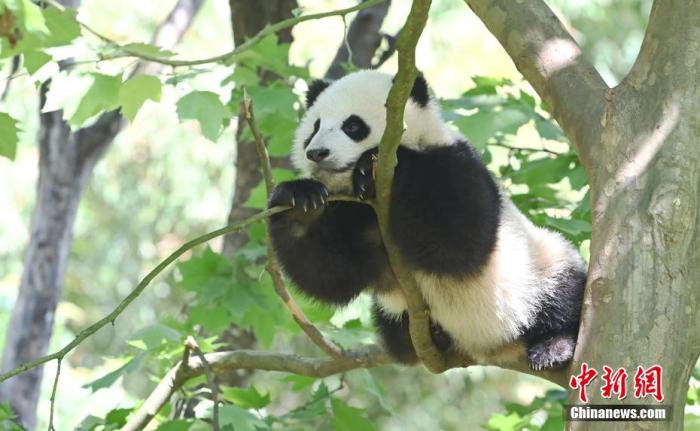China News Service, Beijing, May 22 (Reporter Chen Su) May 22 is the International Biodiversity Day. The reporter learned from the State Forestry and Grassland Administration of China that the protection rate of China's key wild animals and plants has reached 74%. Create a number of national parks.
Data map: The giant panda selling cute on the tree.
Photo by Anyuan
In recent years, China has continued to strengthen the rescue and protection of rare and endangered wild animals and plants and their habitats, and a large number of rare and endangered wild animals and plants have achieved recovery growth.
According to the relevant person in charge of the State Forestry and Grassland Administration, China has systematically implemented the endangered species rescue project, and adopted measures such as in situ protection, ex situ protection, release (return) to nature, artificial breeding (cultivation), etc., effectively protecting 90% of typical terrestrial ecology System type, the wild population of giant pandas has increased to 1,864, the wild population of crested ibis has exceeded 6,000, the wild population of Asian elephants has increased to 300, and the wild population of Tibetan antelope has recovered to more than 300,000.
The elk and Przewalski's wild horses that once disappeared in the wild have established artificial breeding populations in many places. The total number is now about 10,000 and 700 respectively. They have been successfully released into nature, and wild populations have been re-established. The living area and scope are constantly expanding. .
There are nearly 200 botanical gardens of various types and levels, and more than 20,000 species have been collected and preserved.
206 species of rare and endangered plants have returned to the wild, of which 112 are endemic to China.
At the same time, China has completely banned the illegal trade of wild animals and plants, formulated relevant legal supporting systems, continued to increase biodiversity protection, and severely cracked down on the illegal mining of wild plants, damage to the growing environment of wild plants, and illegal business and utilization of wild plants. Trade in ivory, rhino, tiger bones and their products.
In recent years, China has initiated the construction of a system of nature reserves and a system of national botanical gardens with national parks as the main body, forming a relatively complete biodiversity conservation system combining in situ conservation and ex situ conservation.
The establishment of the first batch of national parks in Sanjiangyuan, giant pandas, Siberian tigers and leopards, Hainan tropical rainforest, and Wuyi Mountains, with a protected area of 230,000 square kilometers, covering nearly 30% of the terrestrial national key protected wild animal and plant species.
The aforementioned person in charge said that the National Forestry and Grassland Administration will speed up the construction of a natural reserve system with national parks as the main body, formulate a plan for the spatial layout of national parks, and select about 50 candidate areas for national parks, with a total area of about 30% of the national land area. 10%. This year, a new batch of national parks will be established in areas with important ecological locations and good ecological functions, such as the Qinghai-Tibet Plateau, the Yellow River Basin, and the Yangtze River Basin.
Further increase the protection of key protected wild animals and plants to ensure that by 2025, the protection rate of the number of terrestrial wild animals under national key protection will reach 75%, and the protection rate of the number of terrestrial wild plants under national key protection will reach 80%.
(Finish)

